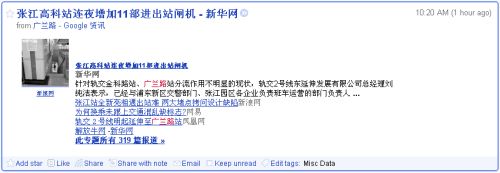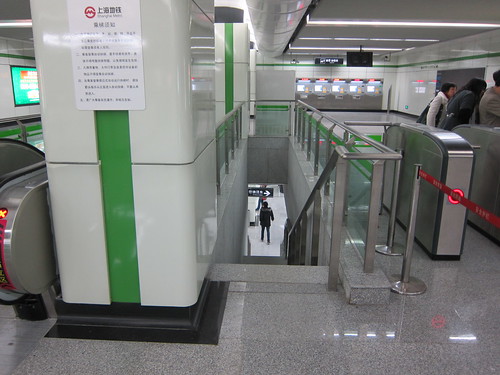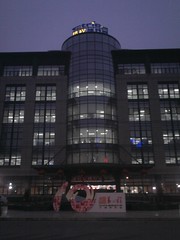Here's online journalism in China.
Yesterday was the opening day of Shanghai's new Line 2 eastern extension towards Pudong Airport. Since the new terminal station, Guanglan Rd, is three blocks from my house, I woke up early and took my camera to get some pictures of the new stations. At work that morning I uploaded the pictures to Flickr and then posted them in a thread on the Metrofans BBS, Shanghai's largest BBS for fans of the city's subway.
Reaction to the new extension has been mixed tending towards negative. One of the focus points of criticism is that the new Zhangjiang High-Tech Park station isn't equipped to handle the high throughput it needs to as the first (and previously, only) station in the area. This includes the charges that the exits are misplaced, that there are too few turnstiles, and that the stairs down to the platform are too narrow. Criticism on this last point was particularly heated because the stairwells really are very narrow compared to all other stairs across the Shanghai subway system and it's a structural problem that should have been easy to foresee and will be hard to correct.
To address the criticism, the Shanghai Metro has added 11 new turnstiles to the station overnight and promised to redesign the stairwells to handle more passengers. This news came to me through a Google News RSS feed in my Google Reader, an RSS entry that features the graphic used by Sina.com to report the news.


Hey, that picture looks familiar.
Oh yeah, it's a black-and-white resized version of one of the photos I took on my morning trip yesterday. Here it is in full color from Flickr:
See the guy on the platform below framed by the stairwell? See the people hunched over the turnstile that was broken and being repaired in anticipation of the morning rush hour? Same image.
Obviously I don't know the chain of posts, reposts (转载), and downloads that lead the Sina editors to my photo. But there are some clues. Obviously the first step was when I posted my photos to the Metrofans BBS and captioned that particular photo with a comment reflecting the already existing opinion that the stairwells were narrow. Next, a link was posted to an article with the inane suggestions that the handrails be taken down as if that would make the space wider, to which another user took my photo and reposted it with the handrail circled for emphasis.

Then, one of the board's super-moderators reposted the modified photo in his own thread with a rant about the Shanghai Metro's ability to create their own "natural wonders". From there, it seems as if the photo was reposted to other BBSs because the Sina photo, though reduced in size, still shows a visible watermark from (I think) bbs.online.sh.cn, one of Shanghai's largest web forums. Looking at the Sina byline, though, shows that the Sina article is actually a reposting of an article from the Dongfang Daily, a Shanghai morning newspaper which had the photo on a page 2-3 spread (PDF) about the troubled Line 2 opening. Incredibly, the print-version of the Dongfang Daily used a cropped version of the same photo. This suggests that reporters at the Dongfang Daily source uncredited photos from online sources, prepare the photos and articles for posting online, edit/crop them for the print version, after which the online version is copied/distributed to other sites across the internet.
I hope it doesn't sound like I'm complaining about all this. I'm actually very happy that my photo was used to enrich the discussion across the internet of the Zhangjiang station troubles. My Flickr photos are licensed under a CC-license only because Flickr doesn't offer a copyleft/public domain/no license option. My preferred license is the WTFPL, and my personal policy is to always credit for things I use (ie Postel's Law).





